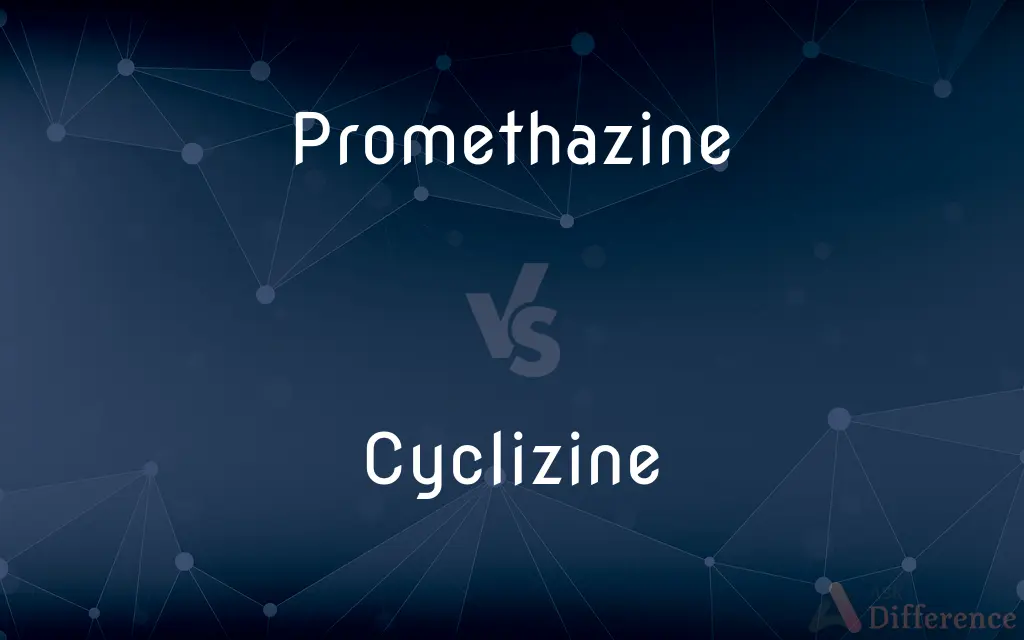Promethazine vs. Cyclizine — What's the Difference?
By Fiza Rafique & Maham Liaqat — Updated on March 27, 2024
Promethazine is an antihistamine used for allergies, nausea, and sedation, whereas cyclizine is primarily used to prevent and treat nausea, vomiting, and dizziness from motion sickness.

Difference Between Promethazine and Cyclizine
Table of Contents
ADVERTISEMENT
Key Differences
Promethazine is a versatile antihistamine with strong sedative properties, widely used to treat allergic reactions, prevent nausea and vomiting, and as a sedative before and after surgery. It operates by blocking histamine and acetylcholine in the body, reducing symptoms of allergy, nausea, and motion sickness. On the other hand, cyclizine is focused more specifically on preventing and treating nausea, vomiting, and dizziness associated with motion sickness, as well as nausea induced by opioids and general anesthesia. It works primarily by blocking histamine receptors in the brain that are responsible for triggering vomiting.
While promethazine is known for its effectiveness in a broad range of applications, including as a preoperative sedative and for treating allergies, it is also recognized for its potential side effects such as drowsiness, dizziness, and dry mouth. Cyclizine, while effective in treating motion sickness and nausea, shares similar side effects but is less likely to be used for allergies or as a sedative. Its use is more common in settings where motion sickness is a concern, such as travel or in certain medical procedures.
Promethazine's anticholinergic effects make it useful in treating extrapyramidal symptoms caused by antipsychotic medications, in addition to its primary uses. This adds another layer of versatility to promethazine compared to cyclizine, which is not commonly used for this purpose. However, both medications are effective in their respective areas, with promethazine offering broader applications while cyclizine focuses on motion sickness and related nausea.
The administration routes for promethazine include oral, rectal, and injectable forms, providing flexibility in how it can be administered based on the patient's needs and the clinical situation. Cyclizine, on the other hand, is typically available in oral and injectable forms, suitable for its primary use cases involving nausea and motion sickness.
In terms of patient preference and clinical considerations, the choice between promethazine and cyclizine often depends on the specific condition being treated, the patient's medical history, and potential side effects. Promethazine's sedative properties might make it a preferred choice for situations requiring sedation, while cyclizine might be favored for targeting motion sickness without the sedative effects to the same degree.
ADVERTISEMENT
Comparison Chart
Primary Use
Allergies, nausea, sedation
Nausea, vomiting, motion sickness
Mechanism of Action
Blocks histamine and acetylcholine
Blocks histamine receptors in the brain
Side Effects
Drowsiness, dizziness, dry mouth
Drowsiness, dizziness, dry mouth
Additional Uses
Preoperative sedation, treating extrapyramidal symptoms
Limited to nausea and motion sickness prevention
Administration Routes
Oral, rectal, injectable
Oral, injectable
Compare with Definitions
Promethazine
Known for its sedative effects.
Doctors may use promethazine as a sedative before surgeries.
Cyclizine
Primarily for motion sickness and nausea.
Cyclizine is effective in preventing seasickness.
Promethazine
Treats motion sickness and nausea.
Promethazine can also relieve nausea from motion sickness.
Cyclizine
Less sedating compared to similar medications.
Cyclizine is preferred for patients who wish to avoid excessive drowsiness.
Promethazine
Has anticholinergic effects.
Promethazine helps in managing symptoms caused by antipsychotic medications.
Cyclizine
Blocks histamine receptors in the brain.
Cyclizine works by targeting the brain's vomiting center.
Promethazine
An antihistamine for allergies, nausea, and sedation.
Promethazine is often prescribed for severe allergic reactions.
Cyclizine
Available in oral and injectable forms.
Cyclizine can be taken as a pill or given as an injection.
Promethazine
Available in multiple forms.
Promethazine can be administered orally, rectally, or by injection.
Cyclizine
Used for opioid-induced nausea.
Cyclizine can be given to patients experiencing nausea from pain medications.
Promethazine
Promethazine is a first-generation antihistamine and antipsychotic used to treat allergies, insomnia, and nausea. It was once widely used as an antipsychotic, although it is generally not used for this purpose now.
Cyclizine
Cyclizine, sold under a number of brand names, is a medication used to treat and prevent nausea, vomiting and dizziness due to motion sickness or vertigo. It may also be used for nausea after general anaesthesia or that which developed from opioid use.
Promethazine
(pharmaceutical drug) A first-generation H1 receptor antagonist derived from phenothiazine, used as antihistamine and antiemetic medication with strong sedative effects.
Cyclizine
(pharmaceutical drug) An antiemetic drug used especially in the form of its hydrochloride C18H22N2·HCl in the treatment of motion sickness.
Promethazine
Antihistamine (trade name Phenergan) used to treat allergies; also an antiemetic used to treat motion sickness
Common Curiosities
What is cyclizine primarily used to treat?
Cyclizine is primarily used to prevent and treat nausea, vomiting, and dizziness from motion sickness.
Is cyclizine effective for allergies?
Cyclizine is not commonly used for allergies; its main use is to treat nausea and motion sickness.
What is promethazine used for?
Promethazine is used to treat allergies, prevent nausea and vomiting, and as a sedative.
Can promethazine be used for motion sickness?
Yes, promethazine can be used to treat motion sickness, in addition to its other uses.
How do the mechanisms of action differ between promethazine and cyclizine?
Promethazine blocks histamine and acetylcholine, while cyclizine primarily blocks histamine receptors in the brain.
Can promethazine treat extrapyramidal symptoms from antipsychotics?
Yes, promethazine's anticholinergic effects make it useful for treating extrapyramidal symptoms.
Do promethazine and cyclizine have similar side effects?
Yes, both can cause side effects like drowsiness and dizziness, but promethazine may have a broader range of side effects due to its anticholinergic properties.
How do I choose between promethazine and cyclizine?
The choice depends on the specific condition being treated, the desired effects (such as sedation level), and individual patient considerations.
Can both medications be injected?
Yes, both promethazine and cyclizine are available in injectable forms, though their other available forms differ.
Which is better for preventing seasickness?
Cyclizine is often preferred for seasickness due to its effectiveness in preventing nausea and vomiting associated with motion sickness.
Is cyclizine a good option for patients needing sedation?
Cyclizine is less focused on sedation compared to promethazine and is primarily used for motion sickness.
Are there any risks in taking promethazine or cyclizine for long periods?
Long-term use of both medications can increase the risk of side effects, and they should be used as directed by a healthcare provider.
Can either medication be used in pediatrics?
Yes, but their use in children should be under the guidance of a healthcare provider due to potential risks and side effects.
Share Your Discovery

Previous Comparison
Fiance vs. Boyfriend
Next Comparison
Empty vs. NothingAuthor Spotlight
Written by
Fiza RafiqueFiza Rafique is a skilled content writer at AskDifference.com, where she meticulously refines and enhances written pieces. Drawing from her vast editorial expertise, Fiza ensures clarity, accuracy, and precision in every article. Passionate about language, she continually seeks to elevate the quality of content for readers worldwide.
Co-written by
Maham Liaqat













































